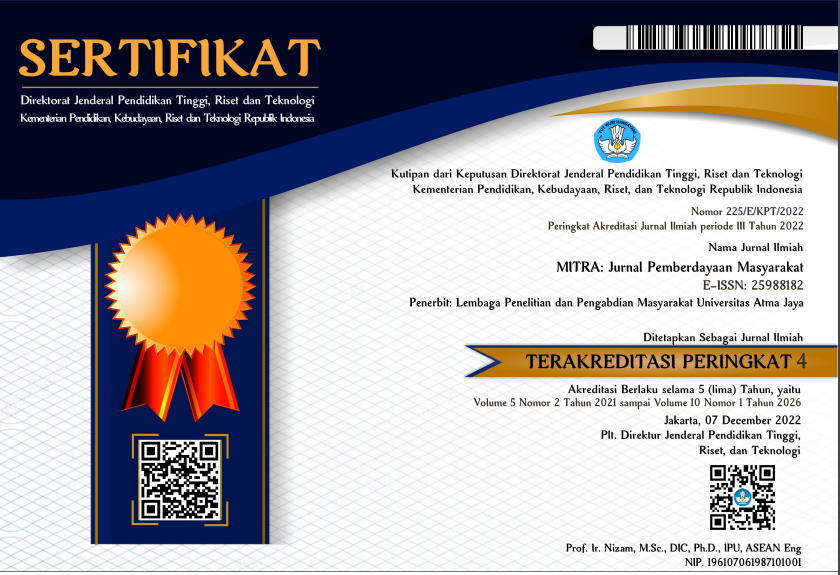Assisting the Production Process of Kefir Milk Soap in the Women's Livestock Group, Blender Village, Kebon Pedes, Bogor
DOI:
https://doi.org/10.25170/mitra.v4i2.1299Keywords:
kefir soap, cow's milk, Women's Livestock Group (WLG)Abstract
This community-empowerment activity was conducted in Blender Village, a cattle rancher village. The community makes a living from raising cattle and selling cow milk. The cow milk is only sold in the surrounding area, and therefore is insufficient to sustain the livelihood of the villagers who are low in economic status. The aim of this community-empowerment activity in the production process of Kefir Milk Soap in the Blender Women's Livestock Group (WLG) was to help the Blender village community able to produce kefir soap, which can later give them additional income. Kefir soap is a kind of soap made from high-quality pure cow milk that is fermented beforehand in its process. Fermentation is done by mixing the milk with kefir seeds and leave it alone for 2-4 days until two parts of viscosity separation of fermented milk are formed. The thick part is selected and mixed with other ingredients (using the hot heating/cooking) method or cold method). Next, it is put into soap moulds and is left for 1-2 weeks before being used. The community-empowerment activity helped the WLG in producing kefir soap and it is hoped that they can train other residents. By being able to make kefir soap, it is hoped that the residents of Blender Village can have additional income and improve their livelihood.
References
Badan Pengawas Obat dan Makanan Republik Indonesia. (2011). Bentuk dan jenis sediaan kosmetika tertentu yang dapat diproduksi oleh industri kosmetika yang memiliki izin produksi golongan B. Jakarta: Badan Pengawas Obat dan Makanan. Codex Alimentarius Commission (2003). Codex standard for fermented milk: Codex STAN 243. Italia: FAO/WHO Food Standards.
Ismanto, S.D., Neswati, & Amanda, S. (2016). Pembuatan sabun padat aromaterapi dari kelapa murni (virgin coconut oil (VCO) dengan penambahan gubal gaharu (Aquilaria malaccensis). Jurnal Teknologi Pertanian Andalas, 20 (2),9-19.
Standar Nasional Indonesia. (2016). SNI 3532:2016. Sabun mandi padat. Jakarta: Badan Standar Nasional Indonesia.
Susanti, A.D., Wibowo, W.A., & Sulistyo S. (2018). Optimasi dan pendampingan proses produksi sabun susu padat di Kelompok Wanita Ternak (KWT) Margo Mulyo
Dusun Dungus Mundu Tulung, Klaten, Jawa Tengah. Diakses dari http://semnasppm.uad.ac.id/wp-content/uploads/6-AriDianaSusanti- semnasppm 2018-hal-39-44.pdf pada 8 September 2019.
Widodo, W. (2002). Boteknologi fermentasi susu. Malang: Pusat Pengembangan Bioteknologi Universitas Muhammadiyah Malang.
Widyasanti, A., Rohani, J.M. (2017). The Making of transparent soap based on olive oil ith the addition of white tea extract. Jurnal Penelitian Teh dan Kina, 20(1),13-29.
Wulansari, P. D., & Ardigurnita, F. (2019). Formulasi sabun alami dengan penambahan susu kambing dan produk turunannya menggunakan metode cold process. Tasikmalaya: Prodi Peternakan Universitas Perjuangan Tasikmalaya.
Downloads
Published
How to Cite
Issue
Section
License
This license allows reusers to distribute, remix, adapt, and build upon the material in any medium or format for noncommercial purposes only, and only so long as attribution is given to the creator. If you remix, adapt, or build upon the material, you must license the modified material under identical terms.







_.jpeg)




.png)
2.png)
.png)
.png)



